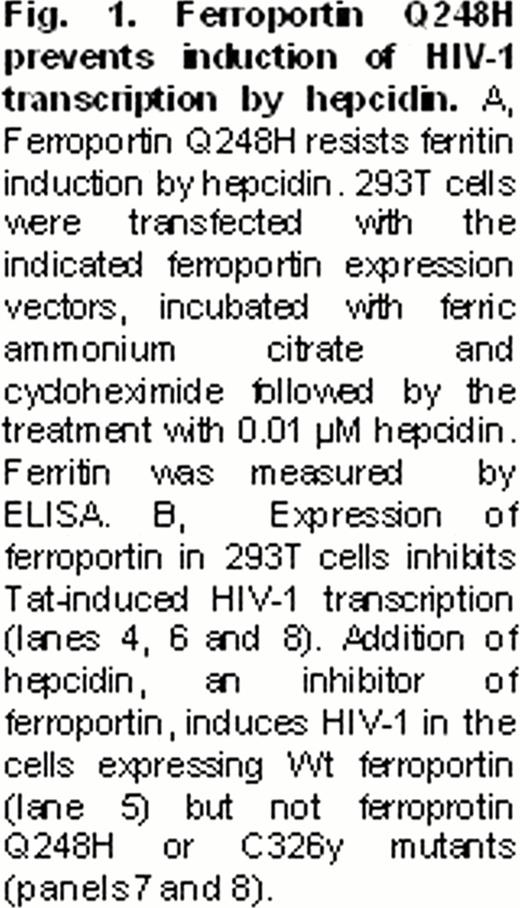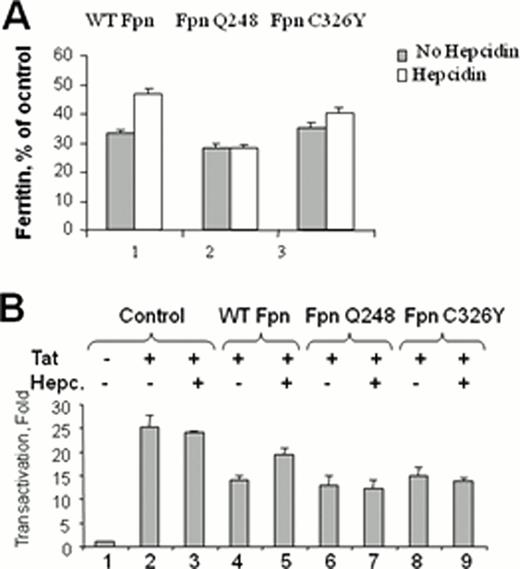Abstract
Abstract 993
Ferroportin is the only iron exporter expressed in mammalian cells, and hepcidin produced by the liver binds to ferroportin leading to its internalization and degradation by lysosomes. We recently reported that expression of ferroportin in 293T cells transfected with HIV-1 LTR-LacZ and Tat expression vector led to decreased HIV transcription, possibly by reducing availability of intracellular iron, and that exposure to hepcidin restored HIV transcription1. The Q248H mutation in ferroportin has an allele frequency of 2.2–13.4% in African populations and is associated with a mild tendency to increased serum ferritin in the general population. The ferroportin Q248H mutation was reported to associate with lower hepcidin levels in HIV-1 infected Rwandese women2. We also recently showed that ferroportin Q248H mutant has reduced sensitivity to physiologic hepcidin concentrations. We expressed WT and Q248H mutant ferroportin in 293T cells that express very low levels of endogenous ferroportin. We also expressed ferroportin C326Y, a mutant that is not sensitive to hepcidin. We analyzed the effect of ferroportin Q248H on cellular Intracellular ferritin levels which reflect the amount of iron stored within the cells. 293T cells were transfected with ferroportin expressing vectors, incubated with ferric ammonium citrate as a source of iron, pretreated with cycloheximide to stop de-novo protein synthesis and then treated with 30 nM hepcidin. Ferritin levels increased significantly in the cells expressing WT ferroportin and treated with hepcidin (Fig.1A). In contrast, ferritin levels remained the same in untreated and hepcidin treated cells expressing ferroportin Q248H or C326Y (Fig.1A). This observation suggests continuing iron export by ferroportin Q248H with low dose hepcidin. HIV-1 transcription can be induced in 293T cells by co-expression of HIV-1 LTR reporter construct and HIV-1 Tat expression vector (Fig.1B, lane 2). HIV-1 Tat binds to TAR RNA located in the beginning of HIV-1 transcript and facilitates a recruitment of a host cell transcription elongation factor, CDK9/cyclin T1, inducing efficient elongation of HIV-1 transcription. Expression of ferroportin WT, Q248H or C326Y mutant inhibited Tat –induced HIV-1 transcription in comparison to non-relevant control (Fig.1B, lanes 3, 4, 6 and 8). Treatment with physiological hepcidin concentrations reversed the inhibition of Tat-induced HIV-1 transcription by WT but not the Q248H or C326Y mutant ferroportin (Fig.1B, lanes 5, 7 and 9). In this experiment, we utilized c-myc tagged ferroportin expression vectors as in our previous study1. We also obtained very similar results with EGFP-fused ferroportin expression, which also allowed an easier detection of reduction in ferroportin expression in the presence of hepcidin. Finally, we also isolated monocytes from two subjects, one with heterozygote and one with homozygote ferroportin Q248H. Monocytes were infected ex-vivo with pseudotyped HIV-1 virus expressing luciferase. HIV-1 replication was reduced in primary monocytes with heterozygote and homozygote ferroportin Q248H as compared to a control. Ferroportin glutamine 248 is located within the intracellular loop (residues 228–307), in close proximity to lysine residues 229–269 which ubiquitination promotes ferroportin internalization3. Future studies should address the details of ubiquitination of human ferroportin Q248H compared to WT ferroportin. An added protection value could be observed lower hepcidin expression levels in HIV-1 infected individuals with the ferroportin Q248H2. Further studies are needed to uncover a mechanism of this reduced hepcidin expression. Further molecular analysis is needed to understand the mechanism of ferroportin Q248H internalization. Taken together, our study shows that the ferroportin Q248H that has a reduced sensitivity to hepcidin may offer an additional protection from HIV-1.
This work was supported NIH Research Grants SC1GM082325, R25 HL003679, 2G12RR003048, 8G12MD007597, K25GM097501 and 1P30HL107253.
No relevant conflicts of interest to declare.
References
Author notes
Asterisk with author names denotes non-ASH members.



This feature is available to Subscribers Only
Sign In or Create an Account Close Modal